Brass instruments are more than trumpet fanfares and tuba oompahs. At the Eastman School of Music’s Brass Weekend from November 8 to 10, Eastman’s brass ensembles will demonstrate that brass instruments are capable of just about anything, from classical transcriptions to electronic a capella music. This is the first year that Eastman presents a “Brass Weekend,” where audiences can enjoy the full range of brass music in back-to-back concerts.
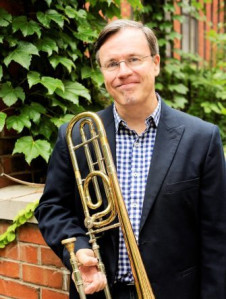
Professor of Trombone, Director of the Eastman Brass Guild, and Co-Director of the Eastman Trombone Choir Mark Kellogg. Photo by Gerry Szymanski.
“They give the listener an opportunity to hear instruments in a way that you’re expecting them to play and also a way that you might be surprised to hear,” says Mark Kellogg, director of the Eastman Brass Guild and co-director of the Eastman Trombone Choir. These groups are a rarity among similar institutions and Eastman audiences benefit greatly from them.
Eastman’s Brass Weekend kicks off on Friday night with a performance by the Brass Guild on Friday, November 8 at 7:30 p.m. in Kodak Hall. This ensemble includes the brass instruments of the orchestra (trumpets, horns, trombones, tubas, plus the wind band’s euphonium), adding up to 18 musicians. However, they frequently break off into smaller cohorts of instruments to explore the vast array of repertoire written for brass. The other ensembles feature their namesake instruments. However, audiences may notice variations on modern instruments like natural horns, as well as differently-voiced instruments in the same family, such as alto, tenor, bass, and contrabass trombones. Tuba Mirum includes the closely-related euphonium.
Kellogg says that the array of brass ensembles at Eastman is rare. Eastman, however, has a long history presenting brass instruments in smaller, instrument-specific ensembles. Starting in 1941, the Trombone Choir is the longest continuously serving ensemble in Eastman’s 100-year history. It also holds the distinction of being the first such curricular ensemble at an American school of music or university.
A unique highlight closes out Brass Weekend, a special concert featuring the Charles Valenza Historic Horn Collection, led by Professor of Horn Peter Kurau. The collection includes over two dozen historic instruments from across the world that were accumulated overtime by Charles Valenza ’50E, ’53E (MM), who studied music theory and horn at Eastman. An independent appraiser valued the collection at $250,000. Prior to his passing in 2019, Valenza gave the instruments to Eastman through a long term loan agreement which stipulated that these were performance horns and not museum pieces.
Although this is Eastman’s first Brass Weekend, it’s unlikely to be the last. Faculty members are already contemplating expanding programming for next year and beyond. For more information on these or any future events at the Eastman School of Music, please visit our Events Calendar website.
Read on to learn more about each concert:
Brass Guild
Friday, November 8 at 7:30 p.m. | Kodak Hall
The Eastman Brass Guild concert demonstrates the range of possibilities on display during this brass weekend. The ensemble performs Anthony Plog’s “Music for Brass Octet,” which mimics church music by breaking up the ensemble into two smaller brass choirs used antiphonally (in call and response), but instead of simple hymnal harmonies, audiences will be treated to an expanded palette of twentieth-century sonorites. A challenging program, the concert will also include works by Michael Tilson Thomas (former conductor of the San Francisco Symphony), Morten Lauridsen, and more.
Also noteworthy is Florence Price’s Octet for Brasses and Piano. Price, who lived from 1887 to 1953, was the first African-American woman to have a musical composition performed by a major orchestra. The Octet was one of the many works discovered in Price’s Illinois summer home only fifteen years ago. Scored for two trumpets, two horns, two trombones, and tuba, and featuring a very prominent piano part which will be played by Assistant Professor Priscilla Yuen, the work has rarely been performed due to its recent re-discovering.
The Eastman Brass Guild will also reprise its performance of this piece on Brass Guild Director Kellogg’s upcoming Faculty Artist Series performance on Sunday, November 17th at 7:30 p.m. in Hatch Recital Hall.
Tuba Mirum
Saturday, November 9 at 2:30 p.m. | Kilbourn Hall
Audiences may be familiar with Eastman’s annual Tuba Mirum event “Tuba Christmas,” which also features a large number of tubas and euphoniums. Associate Professor of Tuba and Euphonium Justin Benavidez, who recently joined the faculty, is hoping to challenge the notion that this group can only play Christmas carols, saying, “a tuba euphonium ensemble is capable of playing anything.”
The result is a diverse program spanning from Baroque composer Jean Joseph Mouret to contemporary singer-songwriter Vienna Teng. Also featured are original works for this kind of ensemble by contemporary composers Barbara York, Stephen Bulla, and John Stevens ’73E.
The ensemble will reprise some of the works, along with others, when it performs this winter at the 42nd annual United States Army Band Tuba-Euphonium Workshop at Fort Myer, Arlington, Virginia for the first time.
“This is a special honor as only a few university ensembles are invited each year to this workshop which includes international artists and attendees,” says Benavidez.
Listeners can tune in via livestream on the United States Army Band “Pershing’s Own” YouTube channel to hear the octet reprise some of the repertoire on this program and more.
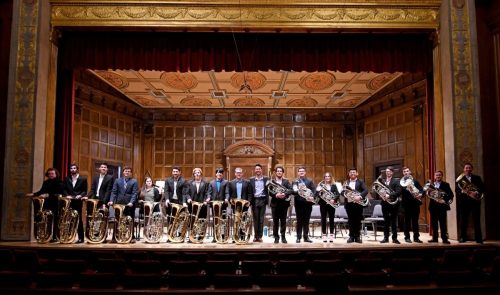
Tuba Mirum in Kilbourn Hall.
Horn Choir
Saturday, November 9 at 5:30 p.m. | Kilbourn Hall
With a concert scheduled only six days after the traditional feast day of the patron saint of the hunt Hubert of Liège, it was only appropriate for the Eastman Horn Choir program to be themed around the history of the hunting horn.
The Horn Choir will display the progression of this traditional style of playing, with arrangements ranging from Rossini’s “Le rendez-vous de chasse” to excerpts from Mozart concerti arranged for soloist and horn octet to the third movement scherzo from Bruckner’s Symphony No. 4.
Kurau notes the stylistic threads between the pieces on the program. “You’re going to hear galloping horses, fanfare gestures, and primal playing at times because back in the day, you would have huge horns and would not have your hand in the bell.”
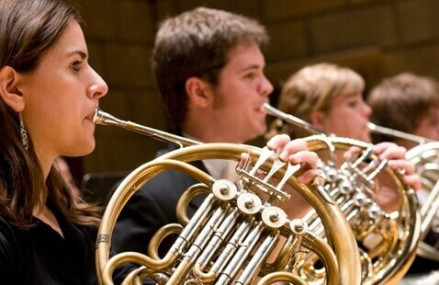
Eastman’s Horn Choir.
Trombone Choir
Saturday, November 9 at 8:30 p.m. | Kilbourn Hall
The Trombone Choir is a cornerstone ensemble at Eastman. Its current directors, Professors Kellogg and Larry Zalkind, have made it a point to honor the group’s incredible legacy while continuing to carve an innovative path forward.
The program features classics connected to Eastman, like Emeritus Professor of Composition Samuel Adler’s “Five Vignettes,” and an arrangement of the traditional song “Scarborough Fair,” by alumnus Bill Reichenbach ’71E, titled “Back to the Fair.” Bridging the studio’s past to its future, current graduate student Vincent Huang ’22E (MM) conducts Reichenbach’s arrangement. The program also features contemporary works like James Kazick’s “Mini-Overture.”
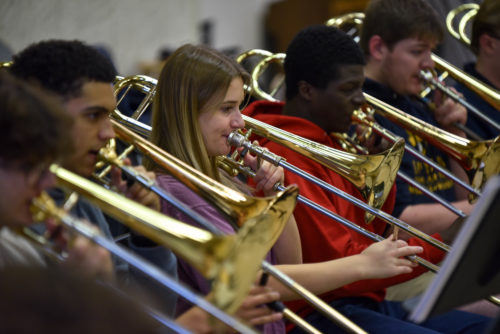
Trombone Choir. Photo by Luke Juntunen.
Valenza Recital
Sunday, November 10 at 2:30 p.m. | Hatch Recital Hall
The Valenza Horn concert––in which audiences will get to see and hear rare historic horns up close––features a myriad of connections to the United States.
These include instruments built by famed Chicago-based maker Geyer and Wisconsin manufacturer Holton. Multiple horns bridge gaps with international makers, including a “Heldenhorn,” built by Gebr. Alexander in Germany but personally designed by Milan Yancich, former Professor of Horn at Eastman and an instrument made by Seraphinoff in Bloomington, Indiana as a reproduction of an instrument designed by Antoine Holari in Paris, which is also housed in the collection.
Many of these historic instruments in the Valenza Collection stand out from those used today. Some of these variations include natural horns, meaning that the player does not use valves and instead operates the instrument by buzzing the desired pitch and changing the position of their hand inside the bell. Audiences will also notice “single horns,” appearing much thinner than the modern instrument and showcasing a compact sound and crisp articulation.
Performing students will give demonstrations of some of the attributes that make these horns special in addition to their performances.
“It’s a very unique opportunity for us,” says Kurau. “We’re the only university in the country that has a horn collection of this kind of breadth.”
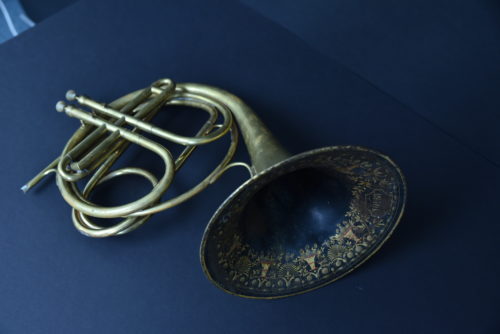
Valenza Horn Collection. Photo by Luke Juntunen.
—-
Written by Andrew Sieradzki ’26E, Eastman Communications Intern
Top photo: Brass Guild in Eastman Theatre by Matt Wittmeyer
